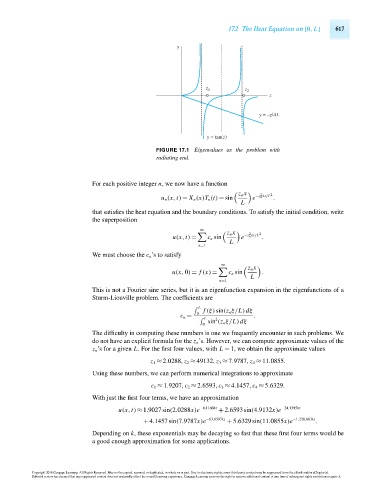Page 637 - Advanced_Engineering_Mathematics o'neil
P. 637
17.2 The Heat Equation on [0, L] 617
y
z 1 z 2
z
y = –z/AL
y = tan(z)
FIGURE 17.1 Eigenvalues as the problem with
radiating end.
For each positive integer n, we now have a function
z n x 2 2
u n (x,t) = X n (x)T n (t) = sin e −z n kt/L .
L
that satisfies the heat equation and the boundary conditions. To satisfy the initial condition, write
the superposition
∞
z n x 2 2
u(x,t) = c n sin e −z n kt/L .
L
n=1
We must choose the c n ’s to satisfy
∞
z n x
u(x,0) = f (x) = c n sin .
L
n=1
This is not a Fourier sine series, but it is an eigenfunction expansion in the eigenfunctions of a
Sturm-Liouville problem. The coefficients are
L
f (ξ)sin(z n ξ/L)dξ
0
c n = .
L 2
sin (z n ξ/L)dξ
0
The difficulty in computing these numbers is one we frequently encounter in such problems. We
do not have an explicit formula for the z n ’s. However, we can compute approximate values of the
z n ’s for a given L. For the first four values, with L = 1, we obtain the approximate values
z 1 ≈ 2.0288, z 2 ≈ 49132, z 3 ≈ 7.9787, z 4 ≈ 11.0855.
Using these numbers, we can perform numerical integrations to approximate
c 1 ≈ 1.9207,c 2 ≈ 2.6593,c 3 ≈ 4.1457,c 4 ≈ 5.6329.
With just the first four terms, we have an approximation
u(x,t) ≈1.9027sin(2.0288x)e −4.1160kt + 2.6593sin(4.9132x)e −24.1395kt
+ 4.1457sin(7.9787x)e −63.6597kt + 5.6329sin(11.0855x)e −1,228.883kt .
Depending on k, these exponentials may be decaying so fast that these first four terms would be
a good enough approximation for some applications.
Copyright 2010 Cengage Learning. All Rights Reserved. May not be copied, scanned, or duplicated, in whole or in part. Due to electronic rights, some third party content may be suppressed from the eBook and/or eChapter(s).
Editorial review has deemed that any suppressed content does not materially affect the overall learning experience. Cengage Learning reserves the right to remove additional content at any time if subsequent rights restrictions require it.
October 14, 2010 15:25 THM/NEIL Page-617 27410_17_ch17_p611-640

